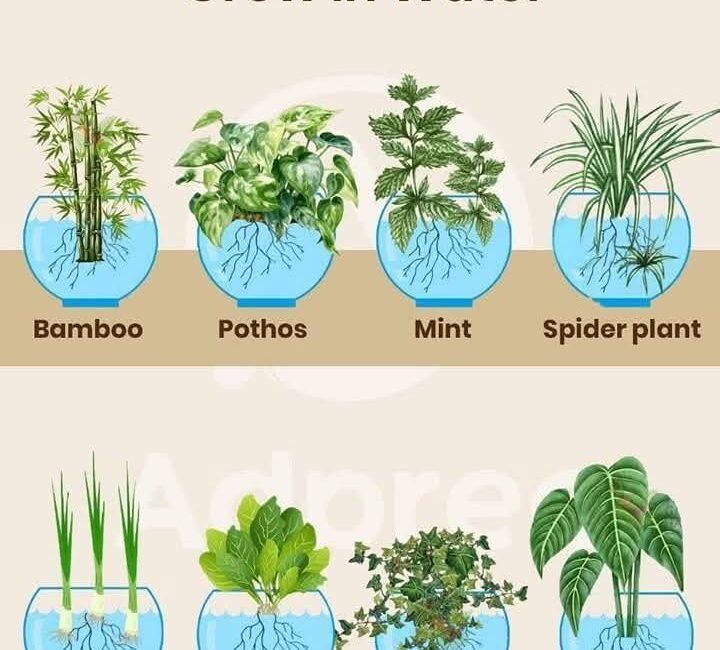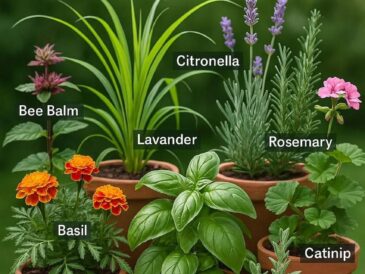The allure of lush greenery indoors is undeniable. There’s something inherently calming about having plants in your home, but what if you could bypass the mess and fuss of soil and cultivate vibrant plants directly in water? This is the magic of hydroponics—a soilless gardening method that’s gaining immense popularity for its simplicity, efficiency, and aesthetic appeal.
Beyond its practical benefits, growing plants in water offers a unique visual charm. The intricate root systems become a feature of your home décor, turning them into beautiful, living works of art. If you’re looking to create a serene, almost aquatic ambiance while enhancing your home’s interior, hydroponics is an ideal solution. In this article, we’ll dive deep into the fascinating world of indoor water plants, explore the best varieties to grow, offer detailed care instructions, and provide expert tips to help you cultivate a thriving aquatic garden in your own home.
Why Choose Water Plants for Your Indoor Oasis?
Before we jump into the specifics of which plants are best suited for hydroponic growth, let’s first take a look at why water plants are a fantastic choice for your indoor space:
1. Cleanliness and Convenience
With traditional soil-based gardening, you’re always concerned with soil spills, repotting, and the mess of dirt. Hydroponics, on the other hand, eliminates the need for potting soil, keeping your home cleaner. Water-based plants are less likely to create a mess, simplifying plant care and maintaining tidiness in your indoor garden.
2. Reduced Pest and Disease Issues
One of the significant advantages of hydroponics is the drastic reduction in soil-borne pests and diseases. Without soil, you are less likely to encounter issues with root rot, fungal infections, or soil-dwelling insects. This translates into healthier plants that are less likely to require heavy intervention with pesticides.
3. Faster Growth and Nutrient Absorption
Water plants can take up nutrients more efficiently than their soil-bound counterparts. Because they have direct access to nutrient-rich water, they often grow faster and require less time to establish a strong root system. This is particularly beneficial for those who want rapid growth and vibrant plant displays.
4. Aesthetic Appeal
Water plants are more than just functional; they are visually striking. The clear water showcases the plant’s roots, creating a living, almost sculptural display. Whether you choose to grow cascading vines or compact aquatic plants, the intricate root systems become part of the décor, creating a soothing and elegant environment in your home.
5. Space Saving
Indoor water gardens are a great space-saving option, especially for those with limited space. Hydroponic systems can be compact, vertical, or tiered, allowing you to maximize your available space without sacrificing the beauty or benefits of having plants in your home. Whether you live in a small apartment or have minimal garden space, growing plants in water can help you create your own indoor oasis.
6. Easy Propagation
Many plants are incredibly easy to propagate in water. Simply cut a stem or a leaf and place it in a container of water, and watch it root over time. Not only does this reduce the cost of buying new plants, but it also allows you to share the joy of hydroponics with friends and family.
The Elite Eight: Best Plants to Grow in Water Indoors
Hydroponic gardening works well with many plants, but some varieties are particularly suited to thrive in water-based systems. Here are the best water plants to grow indoors, each bringing its own unique beauty and benefits to your home:
1. Bamboo (Lucky Bamboo – Dracaena sanderiana)
Description: Despite its name, Lucky Bamboo isn’t a true bamboo. It’s a member of the Dracaena family and is known for its slender, segmented stems and vibrant green leaves.
Care: Lucky Bamboo thrives in indirect light and requires regular water changes to prevent stagnation. Tap water can be used, but distilled or filtered water is preferable to prevent mineral buildup.
Symbolism: In Feng Shui, Lucky Bamboo is believed to bring good fortune, prosperity, and positive energy to the home, making it a popular choice for spiritual and decorative purposes.
2. Pothos (Epipremnum aureum)
Description: Known as Devil’s Ivy, Pothos is a hardy, versatile trailing vine with heart-shaped leaves that come in various colors like green, variegated, and golden.
Care: Pothos can grow in a variety of light conditions, from low light to bright, indirect light. Change the water every week or two, ensuring the roots are submerged but the leaves stay above the waterline.
Benefits: Pothos is an excellent air purifier, helping to remove harmful toxins such as formaldehyde, benzene, and xylene from the air, making it ideal for improving indoor air quality.
3. Mint (Mentha spp.)
Description: Mint is a fragrant, refreshing herb with varieties such as peppermint, spearmint, and chocolate mint. Its aromatic leaves are perfect for culinary uses and teas.
Care: Mint grows best in bright, indirect light and requires frequent water changes to keep the roots healthy. Pinch off the top growth regularly to encourage bushier development.
Uses: Aside from being used in food and drinks, mint can also be an aromatic addition to your space, enhancing the sensory experience of your indoor garden.
4. Spider Plant (Chlorophytum comosum)
Description: Spider plants are popular for their long, arching leaves and “spiderettes” (baby plants) that dangle from stems, making them an attractive addition to any home.
Care: They prefer bright, indirect light and can tolerate some neglect. Change the water every week or two to keep the plant healthy.
Benefits: Like Pothos, Spider Plants are excellent air purifiers and are known to remove harmful substances like formaldehyde and xylene from the air.
5. Green Onions (Allium cepa)
Description: Green onions are a staple in many kitchens and can be easily regrown in water from their bulb ends.
Care: Place the green onion bulb in a glass of water, ensuring the roots are submerged while the rest of the bulb sits above the water. Change the water regularly to keep it fresh.
Benefits: Growing green onions in water gives you a continuous supply of fresh greens for cooking, which is both practical and convenient.
6. Lettuce (Lactuca sativa)
Description: While not a traditional water plant, lettuce can be grown hydroponically with the right support. Varieties such as Romaine or Butterhead thrive in water systems.
Care: Lettuce needs bright light and a nutrient-rich water solution to thrive. Use net pots or another structure to support the lettuce head as it grows.
Benefits: Growing your own lettuce indoors means you have access to a fresh, pesticide-free supply of greens for salads, sandwiches, and more.
7. Ivy (Hedera spp.)
Description: Ivy is a classic trailing vine known for its glossy, deep green leaves. It adds elegance and a touch of nature to your home décor.
Care: Ivy thrives in bright, indirect light and requires regular water changes. Keep the leaves above the waterline to prevent rotting.
Benefits: Ivy helps purify the air by absorbing carbon dioxide and other harmful toxins. It’s also a great way to add a touch of sophistication to your living space.
8. Philodendron (Philodendron spp.)
Description: Philodendrons are a diverse group of plants known for their heart-shaped leaves and low-maintenance needs. They are perfect for beginners.
Care: These plants prefer bright, indirect light and regular water changes. Ensure that the roots are submerged, but the leaves stay above the waterline.
Benefits: Philodendrons are effective at purifying the air and are particularly well-suited to lower light conditions, making them a versatile indoor plant.
Setting Up Your Indoor Water Garden: A Step-by-Step Guide
Now that you know which plants to grow, it’s time to set up your indoor hydroponic garden. Follow these simple steps to get started:
1. Choose Your Plants
Select plants that thrive in water-based systems, such as the ones listed above. Make sure you’re aware of each plant’s care needs, particularly regarding light and nutrient requirements.
2. Select Containers
Use clear glass or plastic containers to showcase the plants’ roots. The transparency allows you to monitor water levels and the growth of the roots. Consider containers that match your home’s décor to enhance the aesthetic appeal.
3. Prepare the Water
Tap water can be used, but it’s best to let it sit for 24 hours to allow chlorine to evaporate. Filtered or distilled water is preferred, especially if your tap water is high in minerals.
4. Clean the Plants
Gently wash the roots of your plants to remove any soil or debris before placing them in water.
5. Place the Plants in Containers
Submerge the roots in the water, ensuring that the leaves stay above the waterline. Be mindful of the water level—do not let the leaves touch the water as this can lead to rot.
6. Provide Light
Place your plants in a location with bright, indirect light. Avoid placing them in direct sunlight, which can heat the water too much and cause damage to the plants.
7. Change Water Regularly
Change the water every week or two to prevent stagnation and ensure the plants receive fresh
nutrients.
Conclusion: Bring Nature Indoors with Hydroponic Water Plants
Hydroponic gardening opens up a whole new world of possibilities for indoor plant enthusiasts. Growing water plants indoors is not only an easy and effective way to maintain lush greenery, but it also offers numerous benefits such as air purification, aesthetic appeal, and a steady supply of fresh herbs and vegetables. By selecting the best plants for water growth and following proper care guidelines, you can create a thriving water garden right in the heart of your home.




